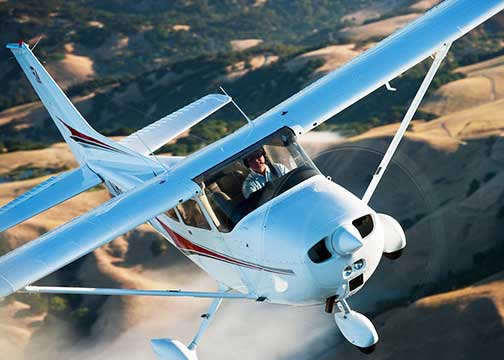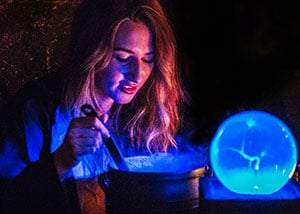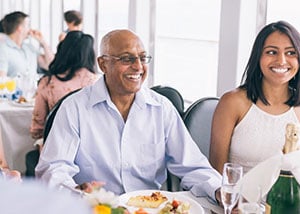Thinking about becoming a pilot? Learning is easier than you’d think!
Imagine slipping into the pilot’s seat, flipping on the controls, and feeling the plane’s engine come to life beneath your fingertips. Experience a wave of excitement as you expertly guide the plane down the runway and into the sky!
Whether you’ve always dreamed of becoming an airline pilot or just want to experience the freedom of flight, obtaining your pilot’s license is extremely exciting and rewarding. However, it can also be expensive, time consuming, and hard to know where to begin.
If you’re feeling a little lost, don’t worry! We’ve broken down the process into 8 easy steps. From booking a discovery flight to passing your practical exams, these steps will make your journey a breeze!

WHAT ARE THE BASIC REQUIREMENTS?
Before getting too far in, we think it’s important to discuss the basic requirements for any pilot. In order to become a student pilot, you must:
- Be at least 16 years old
- Possess a valid driver’s license
- Be able to read, speak, and understand English
If you meet these basic requirements, great! Keep reading to discover how you can become a pilot in 8 steps.
STEP 1: DECIDE WHAT KIND OF PILOT YOU WANT TO BE
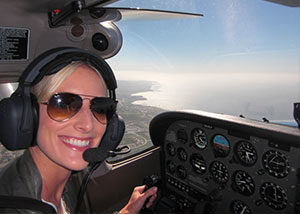
Similar to other hobbies and professions, there’s a variety of different pilot certifications you can work towards. Taking some time to write down your goals will help you decide which certificate you’d like to pursue and help determine your timeline.
Depending on your goals, timeframe, and budget, some certifications will be easier to achieve than others. See below for a more in-depth breakdown of each certificate and their requirements:
Recreational Pilot Certificate
- Perfect for: Pilots looking to fly for fun in their local area
- Required flight time: Minimum of 30 hours (15 training hours)
- Benefits: Fly a small airplane and up to 1 other passenger
- Restrictions: Must be at least 17 years old, daytime flights only, no cross-country flights allowed
Private Pilot Certificate
- Perfect for: Pilots looking to fly for fun and explore regions outside their local area
- Required flight time: Minimum of 40 hours, including night training
- Benefits: Fly passengers in variety of different airplanes, day or night
- Restrictions: Must be at least 17 years old, cannot be hired or paid for flights, additional certificate ratings may be required to fly at certain times
Commercial Pilot Certificate
- Perfect for: Pilots looking to earn money while flying
- Required flight time: Minimum of 150 to 250 hours
- Benefits: Get paid to fly! With this certificate, you can get hired to tow banners, provide sightseeing flights, crop dust, and more
- Restrictions: Must be at least 18 years old, cannot fly passengers on a commercial airline, requires a Second-Class FAA medical certificate
Airline Transport Pilot Certificate
- Perfect for: Pilots looking to make a career out of flying
- Required flight time: Minimum of 1500 hours (100 night flight hours and 500 hours cross-country)
- Benefits: This is the ultimate pilot certificate! With an ATP, you’ll be eligible to fly for most commercial airlines
- Restrictions: Must be at least 23 years old, requires a First-Class FAA medical certificate
STEP 2: OBTAIN A FAA MEDICAL CERTIFICATE
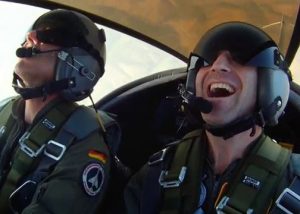
Once you’ve decided which pilot certificate you’d like to pursue, the next step is to make sure you are physically eligible.
In order to become any type of pilot, the Federal Aviation Administration (FAA) requires all students to hold a valid medical certificate. While this step doesn’t necessarily need to come second, we think it’s important to know your flight eligibility before diving into flight lessons.
In order to get a medical certificate, you must undergo an exam performed by a FAA-authorized aviation medical examiner. Based on your health, they’ll either deny your request or approve you for one of three medical certificates:
- First Class (required for airline transport pilots)
- Second Class (required for commercial pilots)
- Third Class (required for students, private pilots, and sport pilots)
Some medical conditions that could disqualify you from getting a medical certificate include epilepsy, coronary heart disease, color blindness, and certain personality disorders. Click here to read the full list.
Once you have your medical certificate, it’s time to take to the skies!
STEP 3: BOOK A DISCOVERY FLIGHT
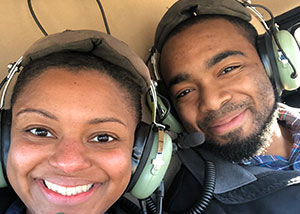
Imagine spending tons of money, time, and energy into becoming a pilot only to realize that it’s not your thing. Bummer, right? That’s why many flight schools offer discovery flights!
During your discovery flight, a certified instructor will take you through a pre-flight inspection before letting you hop in the pilot’s seat! You’ll board a small, modified plane that has controls on both sides of the cockpit. While your instructor handles takeoff and landing, you'll take over and practice basic maneuvers up in the air.
These introductory flights are the perfect time to ask questions and get a feeling for flying. If you love it, great! If not, no harm done.
STEP 4: GET YOUR STUDENT PILOT CERTIFICATE
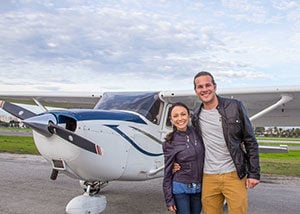
Ok, so you fell in love with flying. Now what? Before you can take to the skies on your own, you must successfully obtain a student pilot certificate.
This certificate differs from others in that it does not require a set number of flight hours. Instead, you must complete an application to the Flight Standards District Office and receive an endorsement from a certified flight instructor.
You’ll likely have to complete several practice flights before qualifying for an endorsement. Don’t worry, these flights can all count towards your required training hours. In general, you’ll need to master the following skills:
- Flight preparation
- Safe takeoffs and landings
- Maintaining positive control of the plane during climbs, descents, and straight flight
- Consistently showing good judgement and safety
Once you have your student pilot certificate, you can officially fly solo and start working toward your goals!
STEP 5: TAKE TO THE SKIES
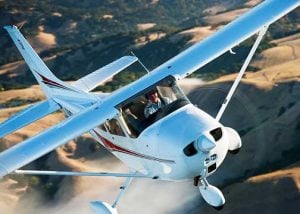
Your first solo flight will be something you never forget! Experience the true freedom of flight as you take off, soar, and land all on your own. Of course, your instructor will still be watching over you from the ground.
As previously mentioned, most pilot certificates require a different amount of logged flight hours before you can be certified. The best way to get them? By flying, of course!
If you happen to own a plane, great! Get out there and start logging hours! However, if you’re like most of us, you’ll need to rent a plane. While most flight schools offer rental packages, the hourly rate can stack up over time. No matter how you rack up hours, be sure to carefully log each one according to FAA standards.
During this time, it’s also important to brush up on your ground training and general flight knowledge. You’ll need it to pass your pilot certification tests!
STEP 6: PASS YOUR PILOT TESTS
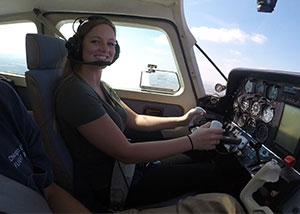
Regardless of the certification, you’ll have to pass several tests before you can secure your ticket to the skies. At the bare minimum, this will include a Pilot Knowledge Test and Pilot Practical Exam.
The knowledge test is a written test covering everything from airplane instruments to Air Traffic Control and Federal Aviation Regulations. While your flight instructor will introduce you to a lot of these concepts during training, you’ll likely have to do a lot of studying on your own. Any questions that you miss can be reviewed and revisited after the test.
Next, your practical exam is a hands-on, oral test given by a FAA-certified examiner. You’ll answer a variety of verbal questions before taking them through your preflight procedures. Then, buckle up for a practice flight where you’ll demonstrate different maneuvers and run through hypothetical emergency situations.
Please note that the Commercial Pilot and Airline Transport Pilot certificates both require additional testing and pilot ratings.
If you pass all of your tests, congratulations! Your official FAA pilot’s certification will be sent to you in the mail.
STEP 7: BOOST YOUR CERTIFICATE WITH PILOT RATINGS AND ENDORSEMENTS

Pilot ratings and endorsements are special add-ons that allow you to fly different types of airplanes or during certain weather conditions. While they do require extra training, you’ll gain valuable experience and become a better pilot!
Some of the most common pilot ratings and endorsements include:
- Instrument Rating: This rating requires 20 additional hours of training and allows you to fly in the clouds or in poor visibility conditions
- Multi-Engine Rating: With this rating, you’ll be able to fly airplanes with more than one engine
- Complex Endorsement: This endorsement allows you to fly airplanes with retractable landing gear, movable flaps, or a controllable-pitch propeller
- High Performance Endorsement: Fly airplanes with over 200 horsepower. This endorsement is necessary if you’re pursuing a Commercial Pilot or Airline Transport Pilot certificate
After boosting your pilot’s certificate with ratings and endorsements, there’s only one thing left to do…
STEP 8: CELEBRATE!
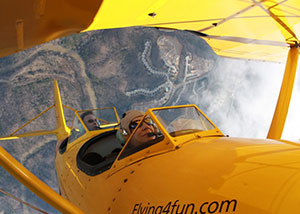
You’ve trained, you’ve studied, and it’s finally official: you’re a certified pilot! Celebrate with a bottle of champagne or take a victory lap across the sky. You deserve it!

